Remembering "Walking With Dinosaurs"
Being aware, through my favorite online sources on paleontology and paleoart, of the recent release of season two of the documentary series Prehistoric Planet, and having just taken a quick glance at the high production values and stunning visual effects, has made me remember the first series of this kind to be ever released, and what a big deal it was back then. Of course I’m talking about the BBC’s Walking With Dinosaurs, produced by Tim Haines, narrated by Kenneth Branagh (or Avery Brooks in the version broadcast in the USA) and released in late 1999 or early 2000, depending on where you lived. At the time, the most convincing dinosaurs we had ever seen on a screen were those created by Industrial Light and Magic and Stan Winston’s Studio for the Jurassic Park movie (which just turned 30, by the way, dating from 1993) and its sequel The Lost World (1997), both works of fiction that, despite showing relatively accurate and highly believable dinosaurs compared to previous efforts, still took many liberties in their depiction for the sake of storytelling (T. rex’s vision being arbitrarily based on movement and Velociraptor being actually based on another, bigger dinosaur are only two examples that have already been mentioned on this very blog).
I found out about the new Prehistoric Planet series through the (highly recommended) Love in the Time of Chasmosaurs blog, which usually deals with vintage paleoart from old dinosaur books but occasionally delves into current media too, with this documentary being one of those exceptions. Incidentally, in a very recent post by Niels Hazeborg they inspected a dinosaur book from the year 2000 called In the Presence of Dinosaurs, written by John Colagrande and illustrated by Larry Felder, which they claim is heavily influenced by Walking With Dinosaurs (and I can see why). This made me realize how influential the show was for me too, and even as late as 2007, many of the illustrations I made for my (ultimately unpublished) dinosaur book were very blatantly “inspired” by what can be seen on the series, as the Diplodocus piece that opens this post proves.
Walking With Dinosaurs was the first educational (for the most part) TV series that tried to show extinct creatures as if they were still alive and being filmed, in a style reminiscent of David Attenborough’s wildlife documentaries. And it almost didn’t get made, as the concept was initially believed to be too expensive for a TV show. Following the path started by Jurassic Park, the series would need a combination of real natural scenarios, animatronics and computer-generated imagery to bring the dinosaurs to life. But while Spielberg’s film only had 9 minutes of wisely used dinosaur footage, this was to be a 6 chapter, 3 hour long documentary series showing nothing more than prehistoric life re-created through special effects. Producer Tim Haines initially approached Industrial Light & Magic to do the effects work on the project, but that turned out to be prohibitively expensive, as every second of dinosaur footage would cost an astronomic $10,000. Fortunately, British graphics company Framestore was able to do the job at a markedly lower cost and reaching a similar, if a bit rougher on the edges, level of quality. And despite being presented as a documentary, it had its own problems regarding accuracy, but in this case they came out of stretching scarce evidence and several unproven hypotheses than from just making stuff up the way the movies did (there’s no actual proof that pliosaur Liopleurodon reached such a titanic size; the same can be said about pterosaur Ornithocheirus; and the peeing male Postosuchus is… rather questionable). But none of those was considered completely impossible back then; just unlikely.
Going back to my Diplodocus piece, it’s so obvious that it was inspired by WWD that I shouldn’t even mention it. Not only did I like the way this creature was depicted on the show; I also found out at that time, through the limited data that I could gather online, that Diplodocus indeed had those little keratinous spines, similar to those on an Iguana, all along the neck, back and tail, and I incorporated that into my drawing. I even misplaced the nostrils at the top of the head, something that’s now seen as incorrect. Also around that time I found out that gigantic diplodocid Seismosaurus was not a valid genus anymore, being considered a bigger species of Diplodocus instead. That’s why I included the bigger individual in the foreground (the one that bends its neck to look back) that seems to be way too big. Their posture, with the neck extended and kept almost parallel to the ground, is also the same as the one shown in the series, and was considered correct back then. Now, it seems that’s being argued against, but that’s a complex discussion that’s way beyond the scope of this post and, honestly, my knowledge of the matter.
One thing that I found puzzling about that same episode, set in the Late Jurassic in North America, is how inaccurately the cranial anatomy of Allosaurus is portrayed, with its bony crests placed on top of its eyes instead of in front of them. This perpetuates an old trope in paleoart and monster movies that I didn’t expect from a project like this. As you will see, putting such a weird choice aside, my own Allosaurus piece borrows a lot from the animals the show gave us, but I chose to put the crests in their right place. There’s one particular clue that tells me there was some practical reason for this, though. In the follow-up program The Ballad of Big Al, which is a biography of sorts of a particular Allosaurus specimen from Wyoming that was exceptionally well preserved and showed injuries and clues about the way it lived and eventually died, Allosaurus looks the same as it did in the main series, except that the bony crests are placed correctly at last. It is possible that they intentionally modified their Allosaurus model in order to be able to reuse it as a different animal in another chapter. At the start of the Cruel Sea episode, a theropod said to be an Eustreptospondylus is shown roaming around a beach before being killed by the Liopleurodon, and from second one it’s obvious that it’s exactly the same CG model that was used to portray the Allosaurus in the previous episode, just painted in different colors. It could be, then, that they decided to make the model look more generic for budgetary reasons, so they could use it again successfully to portray another creature, as they ended up doing. On the other hand, it could also be just an aesthetic choice, as they made the same “mistake” years later with their Giganotosaurus model on the special episode Land of Giants. So, who knows. They also used palette swaps of the same models for the two species of Iguanodon shown in the series, as well as for Utahraptor and Dromaeosaurus.
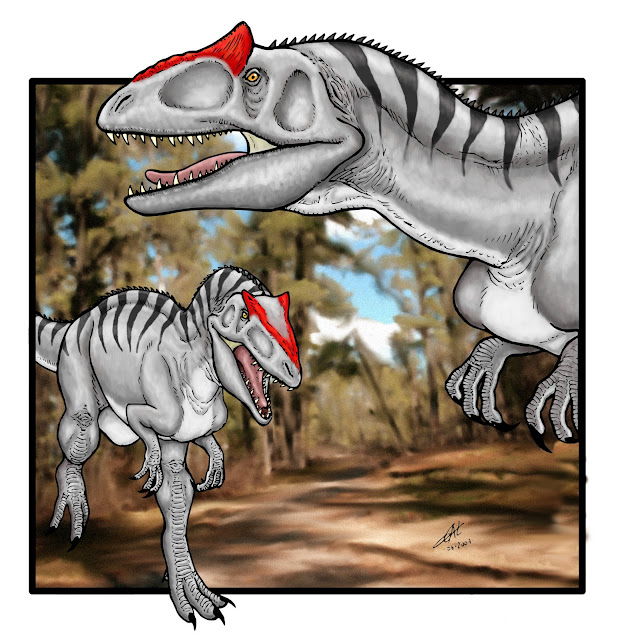 |
| My Allosaurus piece. Obviously influenced by WWD, as you can see. |
Speaking of which, I think this was also the first time I saw Utahraptor portrayed anywhere. I knew about its discovery and fragmentary remains, but this was the first attempt at an actual reconstruction that I ever saw. And just like it, my own piece depicting a Utahraptor was little more than an upscaled Deinonychus. But while the series’ model was a conservatively scaly creature, mine was covered in feathery integument, as it was made several years later, when it had already been confirmed that all Dromaeosaurs were feathered. Of course both are now outdated, as the animal’s skull, found years later, has a markedly different shape, and it most probably had wings like other Dromaeosaurs. Science marches on.
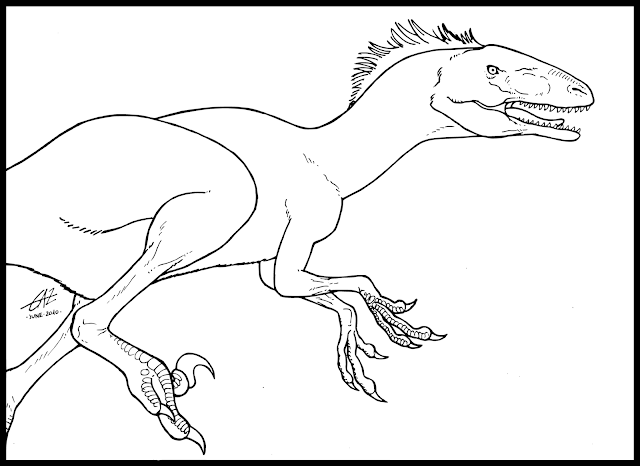 |
| My Utahraptor drawing. Updated version from 2010. The original one was even worse! I never got around to painting this one. |
One thing I had forgotten about, until I went through my old drawings looking for designs to use on print-on-demand sites, is that the show also prompted me to make an Anurognathus drawing. There was a section in my book dedicated to other animals that lived in the Mesozoic era alongside dinosaurs, featuring marine and flying reptiles, synapsids, mammals, crocodylomorphs and other such creatures. Anurognathus is a small pterosaur that makes a brief appearance in the Time of the Titans episode, and an animal of which I don’t think I was aware before seeing it in the series. Or at least it had never caught my attention. It’s possible though that I’d seen it on Peter Wellnhofer’s Illustrated Encyclopedia of Pterosaurs, which I still have.
I also had to be reminded about my Coelophysis drawing, which was also inspired by the show, but I tried to make it look more bird-like. It also looks slightly bulkier and more muscular than the creature shown in the series. The proportions are slightly off, and of course those bunny hands date it a lot. But I like how its face looks like that of a grumpy cassowary.
What definitely did NOT inspire me in the least is the show’s T. rex. I always thought it looked terrible, I can’t put it another way. It looks like a reptilian monster out of a fantasy-horror movie, rather than a real animal. By that time, it was well known that Tyrannosaurus rex and its relatives were actually Coelurosaurs rather than “Carnosaurs”, and therefore more closely related to Dromaeosaurs and birds than to other big theropods like Allosaurus or Giganotosaurus. Yet, there’s nothing in that nightmarish creature that implies it is even remotely related to birds. A weird aesthetic choice and also an unfortunate one in my opinion, but it’s just a notable exception in a series that, for its time, got almost everything right as a novel blend of science education and entertainment.
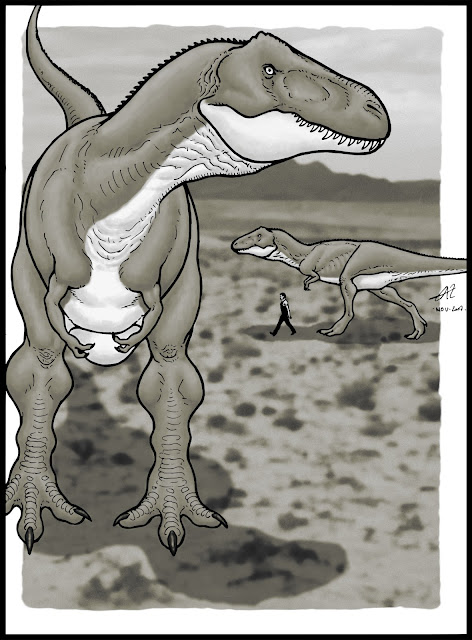 |
| Sepia tone variant of my T. rex drawing. It should be obvious that this one was not inspired by WWD at all. This one may be dated, but at least it looks better than the monstrosity on the show. |
The importance of Walking With Dinosaurs as a pioneering documentary series can’t be overstated, and even if many of the ideas it presented have been rendered incorrect by the advance of the science of paleontology, its legacy is pretty much alive. Not only did the series spawn a series of sequels like The Ballad of Big Al, Walking With Beasts, Walking With Cavemen, Walking With Monsters, The Giant Claw, Land of Giants, Sea Monsters and the 2013 self-titled movie; it also inspired similar documentary series like The Truth About Killer Dinosaurs, When Dinosaurs Roamed America, Dinosaur Planet, Planet Dinosaur (yes, both exist, I’m not even joking) and of course the very recent and most spectacular Prehistoric Planet. Let’s hope more productions inspired by this groundbreaking documentary get made in the future as we increase our knowledge on life millions of years before our own species appeared and, in turn, learn more about life on Earth itself.

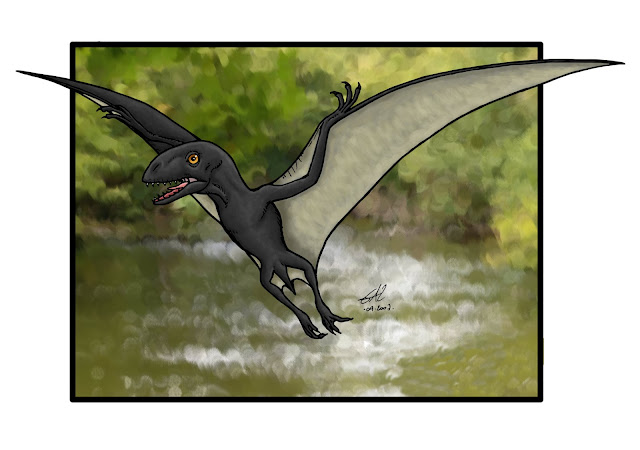
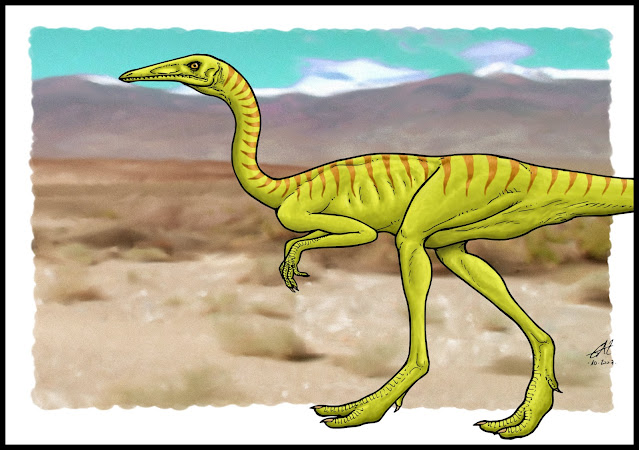


Comments
Post a Comment